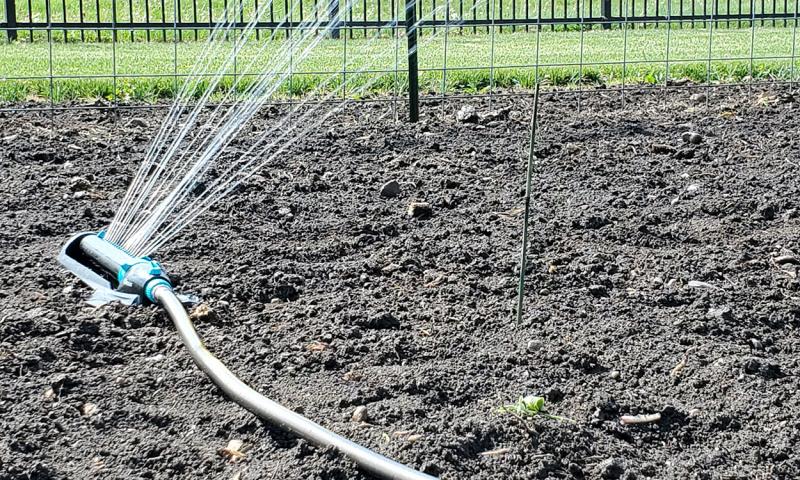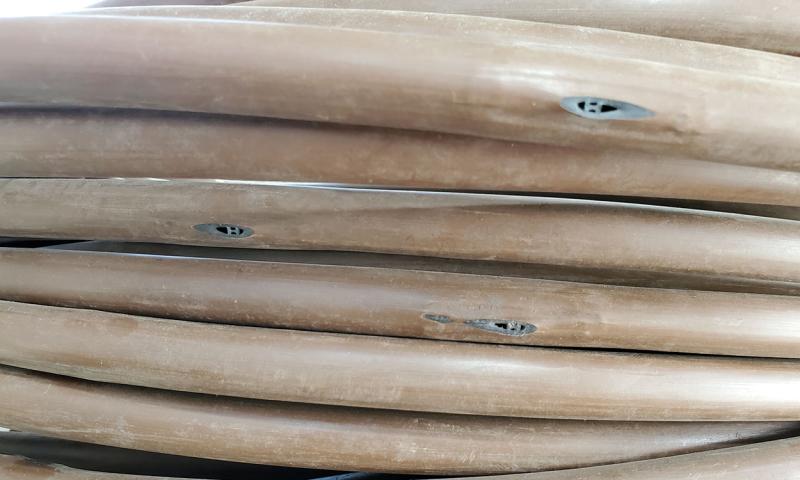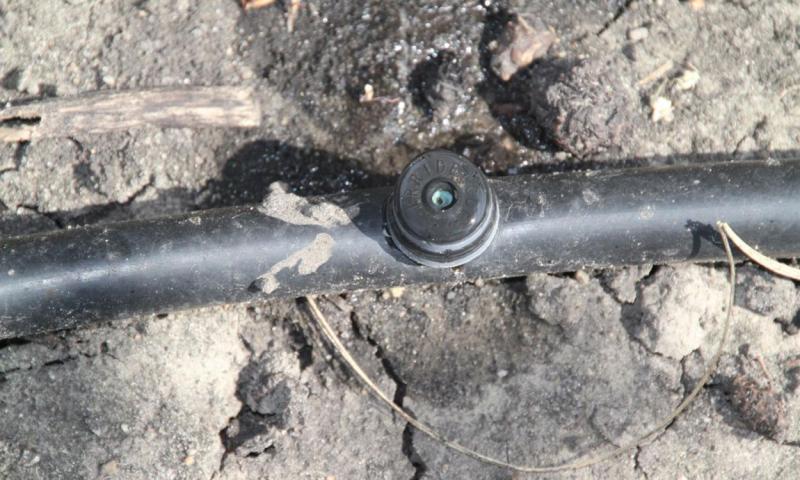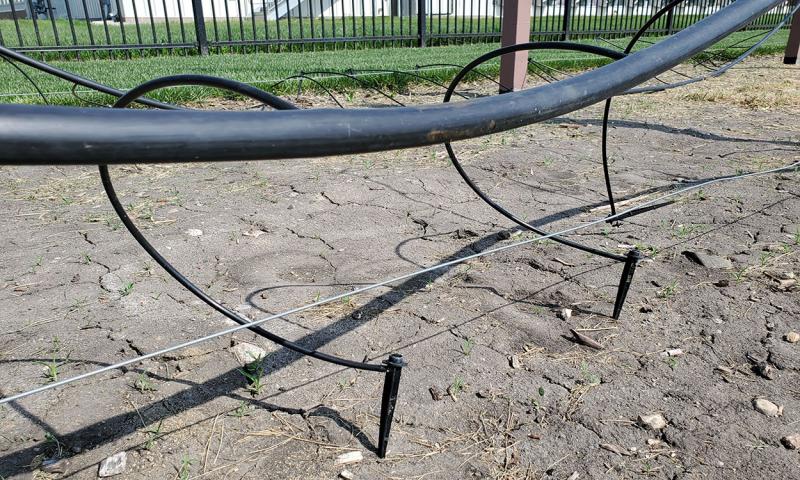Original article by David Graper, former SDSU Extension Horticulture Specialist and Master Gardener Program Coordinator. Updated by Kristine Lang, SDSU Assistant Professor and Extension Specialist in Consumer Horticulture, and Brett Owens, SDSU Instructor of Horticulture and Extension Associate.
Ensuring that your garden plants receive adequate water throughout the growing season does not have to be overwhelming, with a variety of tools to make the process easier. While small-scale gardens, raised beds and containers are manageable with hand-watering, many gardeners employ other methods to manage large spaces and ensure that plants receive the necessary one to 1.5 inches of rain each week during the growing season. In growing seasons where South Dakota experiences drought conditions, water management becomes especially important. Even in a year with normal rainfall, most people will have to water their gardens at least occasionally to get them through the dry periods. Outlined below are several water management options.
Sprinklers

Sprinklers remain a popular option for watering home gardens. Three popular types of sprinklers are oscillating, rotary and fixed-spray sprinklers. Oscillating sprinklers will apply water in a fan pattern with water being applied left to right (Figure 1). Rotary sprinklers can spray water in a 360-degree pattern from the middle, and many can be adjusted to apply water in smaller areas, such as 180 or even 90 degrees. Fixed-spray sprinklers usually have a square or circular pattern of water application that cannot be changed. Traveling sprinklers are also becoming more common; these sprinklers are often designed to “follow” the garden hose as it is laid out across a garden or lawn, and the speed of movement is usually dependent on water pressure.
While sprinklers lessen the burden of hand watering, they do have some disadvantages. Using sprinklers means there is potential to lose a significant amount of water to evaporation, as water is sprayed into the air before landing on the ground. South Dakota winds can make water loss due to evaporation even worse, in addition to making accurate water placement difficult; sometimes sprinkler water is blown off target, not reaching the intended soil during high-wind conditions. Water loss due to evaporation is made worse during hot, sunny summer days, and it may take a large volume of water to achieve an actual accumulation of one inch or more of water within the soil profile, where the thirsty plant roots lie in waiting. To prevent water losses due to evaporation, sprinkler systems should be run early in the morning when wind speeds may be reduced, and temperatures and light conditions are lower.
Another reason to only run sprinklers early in the morning is to allow garden foliage to dry off quickly as the day warms to prevent the spread of water-loving plant diseases. Running sprinklers in the evening, while reducing losses due to evaporation, could lead to the spread of foliar diseases due to prolonged leaf wetness. Sprinkler use may also contribute to the spread of soil-borne diseases. Water droplets from sprinklers can splash soil onto plant leaves and can spread bacterial and fungal diseases from the soil to the lower leaves on the plant. This splashing can be reduced if the garden soil surface is covered with a mulch or landscape fabric. Since sprinklers wet the entire soil surface, garden plants and unwanted weeds both get access to needed moisture for growth; this could lead to more weeds and weeding.
Sprinklers typically need to be moved around the garden to provide adequate coverage of the entire space. Care needs to be taken to avoid knocking over plants as you drag hoses attached to the sprinkler. Also, as plants mature, you need to ensure the sprinkler can spray over taller plants and that the spray pattern is not being blocked. For example, to effectively water a patch of sweet corn, the sprinkler may need to be mounted to a taller post, such as a T-post.
Sprinklers, when used appropriately can be an important tool for garden water management, but there are opportunities to target water placement more accurately in the garden.
Direct Water Placement
Soaker hoses and drip irrigation systems offer several advantages over overhead watering with sprinklers. Using these systems allows you to get water precisely where it is needed, at the base of plants where roots can take advantage of it. That means you have a very-efficient watering system. Little water is lost to evaporation, because you are not sending it up in the air. The plant’s foliage stays dry to reduce disease development and spread. You reduce the amount of water in-between the rows of garden plants, so you will usually have fewer weeds to pull.
When using these irrigation systems, it is wise to purchase and install an in-line water filter, particularly if you are using water from your own well. Particulates and minerals can build up in your drip line and emitters, as well as in ooze hoses. This will eventually clog them up and make them useless. So, use good, clean water when using direct water placement systems and make sure to clean the filter regularly. You might also consider using a timer for any of your irrigation methods, as this could be used to turn water on early in the morning. In-line timers for watering are readily available for purchase, but ensure that you’re setting your timer to water deeply and infrequently to improve plant rooting and drought tolerance.

Soaker Hoses
A soaker hose is a porous hose, often made from recycled tires, that allows water to ooze out of little pores over the length of the hose, where it then soaks into the soil (Figure 2). Soaker hoses are an inexpensive alternative to using a sprinkler where you have a small garden or bed to water, or where you do not want to get water sprayed on other things, like your deck, windows or driveway. Read the package for information on how many hoses you can hook together. Soaker hoses are not pressure regulated, so they should be set on level surfaces or follow the contour of hills to ensure water is flowing out of the entire hose as evenly as possible. If you attach too many soaker hoses together, you may run out of water before the plants at the end of the line can get any. Soaker hoses are flexible, so you can run the hose along garden rows and around plants very easily. If you want to ensure your soaker hose stays in place, you can carefully pin it down using landscape pins (sometimes called sod staples). Soaker hoses may not work as well for watering perennials or shrubs that are more widely spaced apart in the garden, as water is emitted from the entire hose versus being directed at the base of each individual plant. For accurate watering of trees, shrubs and even perennial plants, a drip-irrigation system may be the best option.
Drip Irrigation
Drip irrigation allows for the most-accurate placement of water within garden and landscape beds. Since most drip systems are installed semi-permanently for the growing season, you do not have to drag a hose through your garden as much as you would with a sprinkler system.
There are a few disadvantages to using drip irrigation systems. They are typically more expensive and labor intensive to buy and install, but once you have the system in place, you do not have to move it again, at least until the end of the season. Some of those costs will be offset by the savings you will see on your water bill from using less water to keep your garden growing as compared to watering with sprinklers. Supplies for garden-scale drip irrigation systems can be purchased from some hardware and home improvement stores, as well as online.
If you are planning to dig underground lines for a more-permanent drip irrigation system, make sure you call to have utilities marked before you dig, and remember where your system is in following years so you do not damage it yourself. For large-scale drip irrigation installations (or sprinkler systems) you can seek help from landscape professionals, who can design and install the system for you.

Drip Line
A popular drip irrigation system for gardeners is drip line, which is tubing with emitters built into the hose (Figure 3). They are usually spaced at various intervals, such as every six inches, 12 inches, 18 inches or 24 inches. Each emitter will also have a rating of the volume of water that it will emit over the course of an hour, such as 0.6 or 0.9 gallons per-hour (GPH). If you have a heavy soil that does not absorb water very quickly, you will need to look for a lower GPH and a wider emitter spacing, like every 18 inches, to spread the water out and allow the water to soak in without running off. Lower GPH ratings allow you to cover a larger area from a single feeder source, like a garden hose, but you will have to water for a longer period of time to thoroughly water the whole area. The inline drip irrigation tubing can usually be purchased in rolls of 50, 250 or 500 feet, based on your garden size and needs.

Custom Drip Irrigation
If you want to customize your drip irrigation system to fit your garden layout, you may prefer to purchase a mainline for irrigation and insert your own drip emitters or attach your own drip tubing to the emitters (Figure 4 and Figure 5). These systems work particularly well for planting beds of shrubs and perennials, or for watering a squash or melon planting where you planted the seed in hills. Just lay out the lines where you want them to go and then insert the emitters where your plants are. Drip irrigation emitters come in rated application rates, so you can apply more or less water as needed by different plants based on which emitter(s) you use. You can also purchase drip irrigation kits that will include the tubing of your choice, as well as the various fittings you will need to lay out your drip line for a garden or planting bed.
End-of-Season Maintenance

Soaker hoses and drip irrigation systems can be reused for several years with proper end-of-season maintenance. Soaker hoses and drip lines are typically removed from flower and garden beds at the end of the season. Be sure to drain excess water from the lines and store them in a place where rodents will not damage the plastic materials. Next season the garden can be prepped, planted and lines laid in place once again. For semi-permanent drip systems with custom drip emitters or drip tubing, you may want to leave the system in place over winter. Be sure to disconnect the drip irrigation mainline from your hose or hose bib and let the remaining water drain out. You can also use an air compressor to blow out the excess and reduce the chance of lines bursting during a winter freeze.
Special thanks to SDSU Extension Master Gardeners Tim Schreiner and Stacy Dreis for serving as volunteer copy editors of this article.


